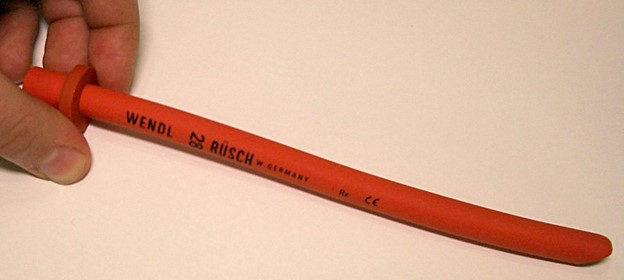Assessment Flashcard 9
Rationale
D. Rationale: The very first step when performing the BLS assessment is to check for responsiveness.
Question
When performing the BLS assessment, what is the very first step after ensuring that the scene is safe?

a. Call for help and activate the emergency response team
b. Look for an AED
c. Check breathing and pulse
d. Check responsiveness
Answer
d. Check responsiveness
Rationale
C. Rationale: The waveform capnography device is connected directly to the endotracheal tube. Therefore, endotracheal intubation is required when measuring the end-tidal CO2 pressure. The device is then connected to a cardiac monitor with capnography capabilities to display the end-tidal CO2 output. The CO2 detector, on the other hand, is a colorimetric device that changes color from yellow to purple in the presence of CO2. It does not measure end-tidal CO2 pressure.
Question
Which of the following devices is required to measure end-tidal CO2 pressure?
a. Oropharyngeal airway
b. CO2 detector
c. Endotracheal tube
d. Compressed air
Answer
c. Endotracheal tube
Rationale
C. Rationale: The S-100B blood marker can be used for prognosticating neurologic outcomes. However, studies have shown high false positive rates. S-100B is not specific for neuronal damage as it can also be increased in hemolysis, neuroendocrine tumors, myenteric plexus, and muscle and adipose tissue breakdown.
Question
Which of the following is a considered blood marker for predicting neurologic outcomes?
a. LDH
b. Troponins
c. S-100B
d. PSA
Answer
c. S-100B
Rationale
D. Rationale: Waveform capnography primarily measures end-tidal CO2. This is the CO2 pressure at the end of the expiratory phase of the respiratory cycle. With this information, providers can measure the gas exchange within the alveoli. If CPR quality is inferior, alveolar gas exchange will not work to expel enough carbon dioxide due to poor pulmonary blood flow and/or ventilation. Studies have shown that patients have poor survival rates if, after 20 minutes of CPR, the end-tidal CO2 remains at 10 mm Hg or below. Hence, it is also a good prognostication tool for cardiac arrest patients.
Question
Which of the following is a function of waveform capnography?
a. Measures end-tidal CO2
b. Prognosticates cardiac arrest patients
c. Monitors CPR quality
d. All of the above
Answer
d. All of the above
Rationale
D. Rationale: Sodium bicarbonate can temporarily correct metabolic acidosis. This is used while the clinician looks for the underlying cause of the patient’s metabolic acidosis.
Question
Which of the following is a pharmacologic treatment to temporarily correct metabolic acidosis in some patients?
a. Epinephrine
b. Chloride
c. Magnesium
d. Sodium bicarbonate
Answer
d. Sodium bicarbonate
Rationale
A. Rationale: Pericardial tamponade is a reversible condition. Treatment includes pericardiocentesis for mild tamponade or emergency thoracotomy when cardiac tamponade is significant in size and volume. Other treatments for pericardial tamponade include volume infusion with a crystalloid solution. Pulmonary conditions such as tension pneumothorax and massive pulmonary embolism are reversible causes of cardiac arrest.
Question
Which of the following is a reversible cause of cardiac arrest?
a. Pericardial tamponade
b. Tension pneumothorax
c. Massive pulmonary embolism
d. All of the above
Answer
a. Pericardial tamponade
Rationale
D. Rationale: Lividity is a sign of irreversible death.
Question
Which of the following is an indication that the patient has irreversible death, and cardiopulmonary resuscitation will no longer be helpful?

a. Absent breathing
b. Unresponsiveness
c. Pulseless
d. Lividity
Answer
d. Lividity
Rationale
B. Rationale: The four universal steps to operating an AED are: 1) power on the AED; 2) attach the electrodes; 3) analyze the rhythm; and 4) press the SHOCK button (after clearing the patient).
Question
Which of the following is NOT a universal step for operating an AED?
A. Power the AED on
B. Hyperventilate the patient prior to administering a shock
C. Clear the patient and press the SHOCK button
D. Attach the electrodes (pads)
Answer
B. Hyperventilate the patient prior to administering a shock
Rationale
A. Rationale: The mnemonic for the BLS assessment that ensures a systematic approach to addressing patients with cardiac arrest is DRS ABCD = danger, response, shout, airway, breathing, circulation, defibrillation. The A-B-C-D sequence is used because we are unsure that the patient is in cardiac arrest and are attempting to provide first aid at this time. When the patient is unresponsive, without pulse or normal breathing, then we shift the sequence to concentrate our efforts to the circulation, airway, breathing sequence.
Question
Which of the following mnemonics is used to sum up the BLS assessment for out-of-hospital patients with potential cardiac arrest?
a. Danger, response, shout, airway, breathing, circulation, defibrillation
b. Danger, response, shout, circulation, airway, breathing, defibrillation
c. Defibrillation, response, shout, circulation, airway, breathing
d. Airway, breathing, circulation, defibrillation, danger, response, shout
Answer
a. Danger, response, shout, airway, breathing, circulation, defibrillation
Rationale
B. Rationale: Waveform capnography reading of 10 mm Hg or less after 20 minutes of CPR is predictive of futility despite the prolongation of CPR. It can be used as one of the factors in determining discontinuation of CPR.
Question
Which of the following physiologic measurements can be used to prognosticate a patient in cardiac arrest during CPR?
a. Oxygen saturation
b. Waveform capnography
c. Electrocardiogram
d. Electroencephalogram
Answer
b. Waveform capnography